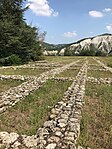Marzabotto
Marzabotto | |
|---|---|
| Comune di Marzabotto | |
 Marzabotto acropolis | |
 Coat of arms | |
show Location of Marzabotto | |
 Marzabotto Location of Marzabotto in Italy | |
| Coordinates: 44°20′20″N 11°12′20″E / 44.33889°N 11.20556°E | |
| Country | Italy |
| Region | Emilia-Romagna |
| Metropolitan city | Bologna (BO) |
| Frazioni | see list |
| Government | |
| • Mayor | Valentina Cuppi |
| Area | |
| • Total | 74 km2 (29 sq mi) |
| Elevation | 130 m (430 ft) |
| Population (30 September 2017)[2] | |
| • Total | 6,826 |
| • Density | 92/km2 (240/sq mi) |
| Demonym(s) | Marzabottesi |
| Time zone | UTC+1 (CET) |
| • Summer (DST) | UTC+2 (CEST) |
| Postal code | 52100 |
| Dialing code | 051 |
| Patron saint | St. Joseph and St. Charles [3] |
| Saint day | March 19 |
| Website | Official website |
Marzabotto (Medial Mountain Bolognese: Marzabòt) is a small town and comune in Italian region Emilia-Romagna, part of the Metropolitan City of Bologna. It is located 27 kilometres (17 mi) south-southwest of Bologna by rail, and lies in the valley of the Reno. The area includes the site of an ancient Etruscan city and also the place of a modern massacre that took place there during World War II.
Etruscan city[]
In and below the grounds of the , close to the city, are the remains of an Etruscan town of the 5th century BC, , protected on the west by the mountains, on the east and south by the river, which by a change of course has destroyed about half of it.[4][5] The acropolis was just below the villa: here remains of temples were found.
The town lay below the modern high-road and was laid out on a rectangular plan divided by main streets into eight quarters, and these in turn into blocks or insulae.[6] Necropoleis were found on the east and north of the site.[7] The place was partially inhabited later by the Gauls, but was not occupied by the Romans.[8]
Map of the Etruscan site
Remains of Etruscan temples at Marzabotto

Remains of Etruscan necropolis at Marzabotto
World War II massacre[]
On September 29, 1944, during the World War II German occupation of Italy, the town was the site of the worst massacre of civilians committed by the Waffen SS in Italy.[9] In reprisal of the local support given to the partisans and the resistance movement, soldiers of the SS-Panzer-Aufklärungsabteilung 16, killed systematically hundreds of civilians in Marzabotto, and in the adjacent Grizzana Morandi and Monzuno.[10] The town was awarded the Gold Medal of Military Valour for this episode. Sculptor Nicola Zamboni created a large monument in the city in 1975 in front of the town hall.[11]
References[]
- ^ "Superficie di Comuni Province e Regioni italiane al 9 ottobre 2011". Istat. Retrieved 16 March 2019.
- ^ "Popolazione Residente al 1° Gennaio 2018". Istat. Retrieved 16 March 2019.
- ^ There are several saints called Charles (Italian: San Carlo). None of their feast days is on March 19, so this may be a local saint. Alternatively, the local church may contain relics of one of the known Saint Charles.
- ^ Pearce, M., R. Peretto, P. Tozzi, DARMC, R. Talbert, S. Gillies, T. Elliott, J. Becker. "Places: 393448 (Marzabotto)". Pleiades. Retrieved March 12, 2016.CS1 maint: multiple names: authors list (link)
- ^ Sybille Haynes (1 September 2005). Etruscan Civilization: A Cultural History. Getty Publications. pp. 188–. ISBN 978-0-89236-600-2.
- ^ Luisa Banti (1973). Etruscan Cities and Their Culture. University of California Press. pp. 9–. ISBN 978-0-520-01910-2.
- ^ Paolo Bernardini; Giovannangelo Camporeale (2004). The Etruscans Outside Etruria. Getty Publications. pp. 182–. ISBN 978-0-89236-767-2.
- ^ The Etruscan town of Marzabotto Archaeological site and National Etruscan Museum "Pompeo Aria" http://www.archeobologna.beniculturali.it/marzabotto/note_en.htm
- ^ Alexander Mikaberidze (25 June 2013). Atrocities, Massacres, and War Crimes: An Encyclopedia [2 Volumes]: An Encyclopedia. ABC-CLIO. pp. 441–. ISBN 978-1-59884-926-4.
- ^ Nigel Cawthorne (24 July 2012). The Story of the SS. Arcturus Publishing. pp. 142–. ISBN 978-1-84858-947-6.
- ^ Luciano Galmozzi (1986). Monumenti alla libertà: antifascismo, resistenza e pace nei monumenti italiani dal 1945 al 1985. La Pietra. p. 152.
- This article incorporates text from a publication now in the public domain: Chisholm, Hugh, ed. (1911). "Marzabotto". Encyclopædia Britannica (11th ed.). Cambridge University Press.
External links[]
- Cities and towns in Emilia-Romagna
- Municipalities of the Metropolitan City of Bologna
- Archaeological sites in Emilia-Romagna
- Recipients of the Gold Medal of Military Valor





